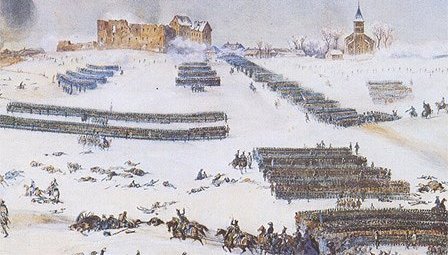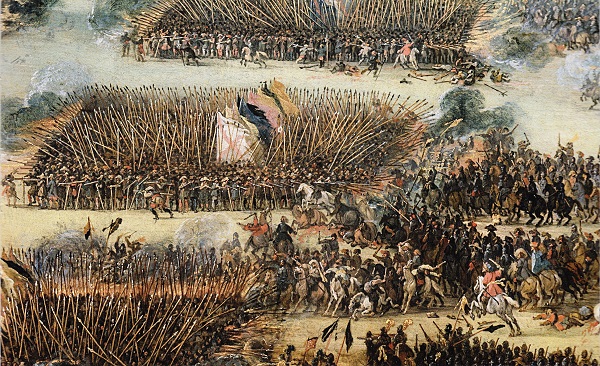- Joined
- May 17, 2016
- Messages
- 1,513
- Reaction score
- 3,018
- Points
- 403
- Age
- 26
- Location
- Regalia.
- Website
- conflee.tumblr.com
Hello! Ill start this by saying I'm far from an expert, nor do I think most of this is extremely relevant for Roleplay, but Aloria is an interesting setting as far as warfare goes especially, because while we have cannons, we lack any rifles, and I'm curious as to how battles would look generally. This is mostly just a for fun discussion and speculation. I brought it up in Discord and we came to a general idea which I think is pretty accurate possibly.
The idea is because cannons lead to larger battle fields with more spread out Asymmetric lines (Napoleonic Wars style), a trend like this would have probably taken hold in Aloria too. Probably early canon warfare and resembling Napoleonic ear less. Lines of men with pikes or spears, farmers mostly, in light armor forming a divided line that maneuvered in chunks and emphasized speed mostly. Cavalry as a right wing and reserves would probably also be very common, possibly screening the friendly artillery to prevent it from being taken. Where prior cavalry would have dominated, making foot armies want to hold the ridgeline of hills, with artillery firing down on them its also possible taking the defilade behind a ridgeline would become more favorable, especially given that was a strategy used in the Peninsular war during Napoleonic times, and is a kind of common sense "oh shit lets hide a bit" reaction to being shelled.
It also depends some on how common cannons are in Aloria. I know Regalia uses them, and has for some time, so its likely other Ailor states have adopted them as well. The Skagger, which often supplements Regalian forces, would probably fair pretty poorly to this style of warfare, though they could be used as a light foot force sent to flank, or likely just crammed in the line at a wing like many 'foreign' allies were in history.
Another possible issue is that one reason battle fields could be traversed so quickly was because people gave up on armor when muskets became the standard. Speed is always favored in these situations especially because of cannons firing on a position if you sit still too long. Regalia's foot army would still need armor obviously, because spears and pikes are used still, but its possible they would opt for much lighter armor still, gambeson and the sort for common levies.
The real fun begins when we consider magic and dragons, and other more fantastical elements that have been utilized. Magic on its own is too rare to be used for units, but for specialized groups with set missions its amazing. Dragons, mainly the Imperial Dragon, could be used a few interesting ways. The obvious one is line disruption. The Dragon can crash into a line and effectively shatter it on his own, making fly-by swoop-smash-retreat tactics very effective. Shatter the line, fly out, let the Cavalry charge in to break it open further and boom you've probably routed most armies.
Scouting is also a powerful use. The Dragon can see the whole field more or less, and isn't common enough for enemy forces to develop reliable strategies to circumvent. He could spot movements, report flankings, or even handle some flank maneuvers himself- if he spots a cavalry charge flanking the right side, he can land, spook the horses, bat a couple dozen men away, and the rest will probably break considering Cavalry is used hit hit and run tactics anyway. Their instinct will be to scatter when they meet resistance- and a Dragon is a hell of a resistance. The Kathar's Towers seem to require some setup time to establish, making them mostly defensive presumably, though that lore isnt known so they may be decent enough at offensive deployment.
Anyyyyway Ive rambled a fair bit. What are everyone else's thoughts? What do you think war would look like in Aloria.
The idea is because cannons lead to larger battle fields with more spread out Asymmetric lines (Napoleonic Wars style), a trend like this would have probably taken hold in Aloria too. Probably early canon warfare and resembling Napoleonic ear less. Lines of men with pikes or spears, farmers mostly, in light armor forming a divided line that maneuvered in chunks and emphasized speed mostly. Cavalry as a right wing and reserves would probably also be very common, possibly screening the friendly artillery to prevent it from being taken. Where prior cavalry would have dominated, making foot armies want to hold the ridgeline of hills, with artillery firing down on them its also possible taking the defilade behind a ridgeline would become more favorable, especially given that was a strategy used in the Peninsular war during Napoleonic times, and is a kind of common sense "oh shit lets hide a bit" reaction to being shelled.
It also depends some on how common cannons are in Aloria. I know Regalia uses them, and has for some time, so its likely other Ailor states have adopted them as well. The Skagger, which often supplements Regalian forces, would probably fair pretty poorly to this style of warfare, though they could be used as a light foot force sent to flank, or likely just crammed in the line at a wing like many 'foreign' allies were in history.
Another possible issue is that one reason battle fields could be traversed so quickly was because people gave up on armor when muskets became the standard. Speed is always favored in these situations especially because of cannons firing on a position if you sit still too long. Regalia's foot army would still need armor obviously, because spears and pikes are used still, but its possible they would opt for much lighter armor still, gambeson and the sort for common levies.
The real fun begins when we consider magic and dragons, and other more fantastical elements that have been utilized. Magic on its own is too rare to be used for units, but for specialized groups with set missions its amazing. Dragons, mainly the Imperial Dragon, could be used a few interesting ways. The obvious one is line disruption. The Dragon can crash into a line and effectively shatter it on his own, making fly-by swoop-smash-retreat tactics very effective. Shatter the line, fly out, let the Cavalry charge in to break it open further and boom you've probably routed most armies.
Scouting is also a powerful use. The Dragon can see the whole field more or less, and isn't common enough for enemy forces to develop reliable strategies to circumvent. He could spot movements, report flankings, or even handle some flank maneuvers himself- if he spots a cavalry charge flanking the right side, he can land, spook the horses, bat a couple dozen men away, and the rest will probably break considering Cavalry is used hit hit and run tactics anyway. Their instinct will be to scatter when they meet resistance- and a Dragon is a hell of a resistance. The Kathar's Towers seem to require some setup time to establish, making them mostly defensive presumably, though that lore isnt known so they may be decent enough at offensive deployment.
Anyyyyway Ive rambled a fair bit. What are everyone else's thoughts? What do you think war would look like in Aloria.








